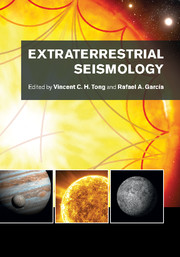Book contents
- Frontmatter
- Contents
- List of contributors
- Preface
- Acknowledgements
- List of abbreviations
- Planetary seismology: High risk, high return
- A bright outlook for helio- and asteroseismology
- Part I Observation and space missions
- Part II Data and physical parameters
- Part III Modeling approaches
- Part IV Discoveries of physical structures and processes
- 11 Asteroseismology of red giant stars
- 12 A helioseismic view of the Sun's internal structure and dynamics
- 13 Recent discoveries of structures and physical processes in local helioseismology
- 14 Seismology of giant planets
- 15 Seismicity and interior structure of the Moon
- Part V Interdisciplinary research involving planetary and astrophysical sciences
- Part VI Interdisciplinary research involving terrestrial seismology
- References
- Index
12 - A helioseismic view of the Sun's internal structure and dynamics
from Part IV - Discoveries of physical structures and processes
Published online by Cambridge University Press: 05 July 2015
- Frontmatter
- Contents
- List of contributors
- Preface
- Acknowledgements
- List of abbreviations
- Planetary seismology: High risk, high return
- A bright outlook for helio- and asteroseismology
- Part I Observation and space missions
- Part II Data and physical parameters
- Part III Modeling approaches
- Part IV Discoveries of physical structures and processes
- 11 Asteroseismology of red giant stars
- 12 A helioseismic view of the Sun's internal structure and dynamics
- 13 Recent discoveries of structures and physical processes in local helioseismology
- 14 Seismology of giant planets
- 15 Seismicity and interior structure of the Moon
- Part V Interdisciplinary research involving planetary and astrophysical sciences
- Part VI Interdisciplinary research involving terrestrial seismology
- References
- Index
Summary
Introduction
The frequencies of the global resonant modes of oscillation of the Sun depend on its structure and dynamics. Since we are able to observe and determine frequencies of many of the Sun's oscillation modes, the observed frequencies can be “inverted” to determine solar structure and dynamics. Inversions of solar oscillation frequencies have proved to be extremely successful in determining solar internal structure and dynamics as well as in testing solar models and inputs to solar models. We discuss here some of the major results that have been obtained through inversions. Recent reviews of inversions for solar structure and dynamics may be found in Christensen-Dalsgaard (2002), Basu and Antia (2008), and Howe (2009).
There are a number of sources, both ground based and space based, for helioseismic data. The Birmingham Solar Oscillation Network (BiSON; Chaplin et al., 1996) is the predominant ground-based source of data for modes of low spherical-harmonic degree ℓ (0 ≤ ℓ ≤ 3) while the Global Oscillation Network Group (GONG; Hill et al., 1996) is the source of ground-based intermediate degree modes (ℓ up to about 150). Instruments such as Global Oscillations at Low Frequencies (GOLF; Gabriel et al., 1997) and Variability of solar Irradiance and Gravity Oscillations (VIRGO; Lazrek et al., 1997) on the Solar and Heliospheric Observatory provide space-based data on low-degree modes, while MDI was until recently the source of intermediate degree data. The Helioseismic and Magnetic Imager (HMI; Scherrer et al., 2012) on board the Solar Dynamic Observatory (SDO) collects data on modes up to ℓ = 3000, though the frequencies of all visible modes cannot be determined easily.
Solar structure
As described in Chapter 9, inversions to determine solar structure proceed through the linearization of the oscillation equations around a known solar model. What is obtained from the inversions is the relative differences in the structure – in particular between the sound speed, density, or adiabatic index Γ1 profiles – of the Sun and the model.
- Type
- Chapter
- Information
- Extraterrestrial Seismology , pp. 170 - 179Publisher: Cambridge University PressPrint publication year: 2015



